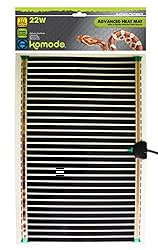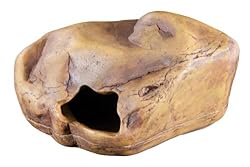Once set up, leopard geckos are relatively easy to care for, but you must get their home just right, because geckos have very specific needs which are different to mammals, and these needs cannot be met without the proper kit and equipment.
Here is a basic guide of the essential things you’ll need to buy before getting your first gecko. I highly recommend doing lots of your own research too, because it is impossible for me to include every single piece of knowledge here.
Please also see: What’s inside my leopard gecko’s vivarium…
Contents:
- Enclosure
- Heating
- Substrate
- Feeding dishes
- Shelter
- Decorations
- Companions
- Summary of housing requirements
Enclosure
You’ll need to house your leopard gecko in a suitably-sized tank, aquarium, terrarium or vivarium. There are many of these in pet stores and online (where the same product tends to be much cheaper) in varying sizes. The type you choose depends on your personal aesthetic preference, space available, number of geckos etc.
 The housing should be over 2ft (60cm) long for a single fully-grown adult gecko, and tall enough that the gecko’s movement isn’t restricted. Leopard geckos are naturally rather curious, so although they don’t climb up smooth surfaces, they do like to explore and climb on top of rocks, hides and on plants that are in their enclosure, therefore a reasonable amount of height is preferable.
The housing should be over 2ft (60cm) long for a single fully-grown adult gecko, and tall enough that the gecko’s movement isn’t restricted. Leopard geckos are naturally rather curious, so although they don’t climb up smooth surfaces, they do like to explore and climb on top of rocks, hides and on plants that are in their enclosure, therefore a reasonable amount of height is preferable.
As the enclosure needs to keep warm, it is also important that it isn’t so big that heat is lost, or that it is so large the gecko gets lost and can’t find the warm area of its home.
I have two of the ones linked below (in black) but the beech colour in my opinion makes it easier to see your geckos :
Vivarium 24x15x15 Inch Repti-life Vivarium in Beech Flatpacked
Heating
It is important that the geckos’ enclosure provides ample heating, as they cannot generate their own heat, and the best way to do this is by buying a heat mat.
Komodo Advanced Heat Mat 22W (410x274mm)
The heat mat should cover about one third of the total ground space, giving the enclosure a warm side and a cooler side. This gives the gecko the ability to regulate their own heat and choose which area they would like to stay in.
Many pet stores will try to sell a heat lamp to new leopard gecko owners but this is not necessary, and could even be dangerous for your gecko. In the wild, geckos get their heat from lying on sun-heated rocks and in warm enclosed spaces; never in direct sunlight. It is possible to distress your gecko with too much heat, so unless you really cannot achieve the correct temperature with a heat mat alone, you should avoid buying a heat lamp for your gecko.
 Habistat Thermostat 600W White
Habistat Thermostat 600W White
To make sure the temperature of your heat mat doesn’t get too much for your gecko, it should be connected to a thermostat, with the temperature being set to around 28C (or 85F) – see below image of HabiStat thermostat. The sensor should be placed on top of the substrate, near the area where your geckos stomach would be resting.
Many leopard gecko owners also choose to have a thermometer to monitor the internal temperature of the enclosure, and a hydrometer to monitor humidity levels (it should be 20%-40%). If the tank isn’t humid enough, a spritz of water or adjustment to the airflow usually rectifies this.
I have written in more detail about how to set up your underfloor heating, with diagrams, in this post: How to set up floor heating for leopard geckos
Substrate
Substrate is the flooring of your leopard gecko terrarium, and there are many to choose from. Some good, some bad, and some ugly. Leopard geckos will lie on the substrate to transfer heat into their bodies, so there should always be flat areas available to allow them to do this.
Firstly, many pet shops will try to sell sand substrate, but it is well-known among gecko owners that ANY loose substrate (so sand, calci-sand, wood chippings, coconut fibre) is bad for geckos because it can cause impaction when ingested by the gecko, leading to illness or death. The gecko may accidentally ingest sand when catching prey, pulling off their skin when shedding, or through licking the sand itself.
Read more on my post: Does sand/ loose substrate cause impaction in leopard geckos?
However pet shops will continue to sell these substrates because of the high profit margins, but please be aware that there are safer options available.
Slightly better options are things like repti-carpet, which will not get ingested, however fibers can come loose and your gecko could get its toes caught in. Also the carpet is not the easiest substrate to clean, so can be a breeding ground for bacteria.
Many people use kitchen towels, as they are easy to replace and cheap, but aesthetically they are not particularly nice to look at, and can go soggy very quickly.
However the best options seem to be tiles, slate or vinyl/lino. They are cheap, easy to clean, last for a long time, are similar to the rocks in the geckos’ natural habitat, but most importantly – have zero risk of causing impaction!
We are now selling vinyl substrate: click here to purchase some
Read more: Vinyl substrate for leopard geckos: Review and Which is the best substrate for leopard geckos?
Feeding dishes
Feeding dishes with smooth surfaces are ideal for keeping mealworms in place, as they will not be able to climb over the edges. There are plenty of mealworm dishes online, but you could even use tealight holders, ramekins or any other smooth small dish, and this will do the trick.
See: Review: Feeding dishes for leopard geckos
 Demiawaking Aquarium Ornament Flower Reptile Food and Water Dish Drinking Feeding Bowl Tortoise Food Dish
Demiawaking Aquarium Ornament Flower Reptile Food and Water Dish Drinking Feeding Bowl Tortoise Food Dish
A water dish should be shallow enough that your gecko would not drown if it got stuck, but large enough that it won’t dry out. There are water dishes available which have little steps on them, which can aid escape should the gecko get into difficulty. Geckos don’t tend to drink a lot as they get most of their hydration from their diet, but it’s good to keep the water there just in case, as they will sometimes flick their tongues on the water if they are thirsty.
Also see: Do leopard geckos need water?
It is good practice to also keep a small pot of calcium available in the enclosure, as this is essential for a healthy gecko, and the gecko will help itself to calcium if it is needed. A calcium and vitamin deficiency will lead to metabolic bone disease, so this small addition can prevent future problems with your gecko. The calcium can simply be put into a bottle top, and left by the feeding dish (for more info see Diet and Nutrition).
Shelter
As prey animals, geckos naturally seek enclosed spaces as a place to sleep, shed and hide. It is important that you provide them with enough safe places for them to spend time so they don’t feel stressed.
As mentioned before, your gecko will need both warmer and cooler areas of the enclosure, and you will need a hide for each of these areas.
Warm hide – this is the hide where your gecko will spend most of its time during the day. Place this directly over the substrate which has the heat mat beneath it.
Moist hide – this is also an important hide, and should be kept moist with damp moss, kitchen roll or EcoEarth. Your gecko will seek a moist area when it needs to shed its skin, and this would either be suitable on the middle or the cool side of the enclosure, as the water will not evaporate as quickly.
 Pet Ting Rocky Hideaway Ornament Resin Reptile Rock Cave Hiding Spot Lizards
Pet Ting Rocky Hideaway Ornament Resin Reptile Rock Cave Hiding Spot Lizards
Optional hide – placing an additional hide in the enclosure is not essential, but certainly preferable, as it gives your gecko more options to regulate its heat and choose the environment it needs to be comfortable.
Decoration
Bridges and things for your leopard gecko to climb to get a vantage point are always a nice addition. I bought these Flexi Stix for mine, and they get used so much, both as a hide and as something to sit on.
Also see: Komodo Flexi Stix Review
Artificial plants can be used when your leopard gecko is out of its hide, as it can provide extra security and also a surface to rub themselves against when they are trying to shed.
Artificial plants can also add to the aesthetic appeal of the tank, are easy to clean, and don’t require the attention live plants would need.
You can also decorate the enclosure with rocks, logs and small ornaments, which your gecko may choose to sit on and explore.

Do you think a clear tank alone would be a bit boring? Maybe you can decorate it with Custom Stickers featuring geckos, plants, rocks, etc.
This might encourage the geckos to explore their surroundings and make their overall living environment look more lively and harmonious.
Companions
You should never house multiple males together as they are very territorial and are guaranteed to fight – usually to the death.
Many people believe that multiple females are happy to be housed together, provided that they are a similar size and age, however I would advise against this; I have seen several cases where females have fought, resulting in bloody wounds.
Sexually mature male and female geckos shouldn’t be housed together unless it’s for breeding, in which case the male tends to be introduced to an enclosure of multiple females, for a finite amount of time.
Males will repeatedly try to mate with females, which can be stressful and shorten the lifespan of the female.
To summarize: I do not believe in co-habitation. In the wild leopard geckos are solitary creatures so I strongly believe this should also be the case in captivity too.
Please see: Is it safe to cohabit leopard geckos?
Summary of essential housing requirements:
- Enclosure, at least 2ft (60cm long)
- Heat mat (to cover 30% of enclosure)
- Substrate (please do not use loose substrate)
- Thermostat (hydrometer, thermometer also recommended)
- Minimum of 2 hides (3 is preferable)
- Moss or (something absorbent) for the moist hide
- Water dish
- Feeding dish
- Calcium dish
- Decorations
Get Your Free Leopard Gecko Care Checklist!
Are you ready to give your leopard gecko the best care possible? Download our FREE PDF e-book featuring a comprehensive care checklist!
This handy guide covers everything from habitat setup to feeding and health tips, ensuring your gecko thrives.
👉 Download your checklist now!









